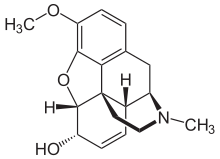
Back كودين Arabic كودايين ARZ Codeína AST Kodein Azerbaijani کدئین AZB Кадэін Byelorussian Кодеин Bulgarian Codeïna Catalan Kodein Czech Codin Welsh
 | |
 | |
| Clinical data | |
|---|---|
| Pronunciation | /ˈkoʊdiːn/ |
| Other names | 3-Methylmorphine |
| AHFS/Drugs.com | Monograph |
| MedlinePlus | a682065 |
| Pregnancy category |
|
| Dependence liability | High |
| Addiction liability | High[2] |
| Routes of administration | By mouth, rectal, subcutaneous injection, intramuscular injection |
| Drug class | Opiate Antitussives |
| ATC code | |
| Legal status | |
| Legal status |
|
| Pharmacokinetic data | |
| Bioavailability | Oral: ~90% |
| Metabolism | Liver: CYP2D6 (to morphine), CYP3A4 (to norcodeine), UGT2B7 (to 3- and 6-glucuronides of codeine, norcodeine, and morphine)[4] |
| Metabolites | • Morphine • Norcodeine • Others (e.g., conjugates) |
| Onset of action | 15–30 minutes[3] |
| Elimination half-life | 2.5–3 hours |
| Duration of action | 4–6 hours[3] |
| Identifiers | |
| |
| CAS Number | |
| PubChem CID | |
| IUPHAR/BPS | |
| DrugBank | |
| ChemSpider | |
| UNII | |
| KEGG | |
| ChEBI | |
| ChEMBL | |
| CompTox Dashboard (EPA) | |
| ECHA InfoCard | 100.000.882 |
| Chemical and physical data | |
| Formula | C18H21NO3 |
| Molar mass | 299.370 g·mol−1 |
| 3D model (JSmol) | |
| |
| |
| | |
Codeine is an opiate and prodrug of morphine mainly used to treat pain, coughing, and diarrhea. It is also commonly used as a recreational drug. It is found naturally in the sap of the opium poppy, Papaver somniferum.[3][5] It is typically used to treat mild to moderate degrees of pain.[3][failed verification] Greater benefit may occur when combined with paracetamol (acetaminophen) or a nonsteroidal anti-inflammatory drug (NSAID) such as aspirin or ibuprofen.[3] Evidence does not support its use for acute cough suppression in children or adults.[6][7] In Europe, it is not recommended as a cough medicine in those under 12 years of age.[3] It is generally taken by mouth.[3] It typically starts working after half an hour, with maximum effect at two hours.[3] Its effects last for about four to six hours. Codeine exhibits abuse potential similar to other opioid medications, including a risk of habituation and overdose.[3]
Common side effects include vomiting, constipation, itchiness, lightheadedness, and drowsiness.[3] Serious side effects may include breathing difficulties and addiction.[3] Whether its use in pregnancy is safe is unclear.[3] Care should be used during breastfeeding, as it may result in opiate toxicity in the baby.[3] Its use as of 2016 is not recommended in children.[8] Codeine works following being broken down by the liver into morphine; how quickly this occurs depends on a person's genetics.[3]
Codeine was discovered in 1832 by Pierre Jean Robiquet.[9] In 2013, about 361,000 kg (795,000 lb) of codeine were produced while 249,000 kg (549,000 lb) were used, which made it the most commonly taken opiate.[10] It is on the World Health Organization's List of Essential Medicines.[11] Codeine occurs naturally and makes up about 2% of opium.[9]
- ^ a b "Codeine Use During Pregnancy". Drugs.com. 3 February 2020. Archived from the original on 30 December 2019. Retrieved 7 February 2020.
- ^ Bonewit-West K, Hunt SA, Applegate E (2012). Today's Medical Assistant: Clinical and Administrative Procedures. Elsevier Health Sciences. p. 571. ISBN 9781455701506. Archived from the original on 10 January 2023. Retrieved 20 August 2019.
- ^ a b c d e f g h i j k l m n "Codeine". The American Society of Health-System Pharmacists. Archived from the original on 18 January 2016. Retrieved 5 January 2016.
- ^ Shen H, He MM, Liu H, Wrighton SA, Wang L, Guo B, Li C (August 2007). "Comparative metabolic capabilities and inhibitory profiles of CYP2D6.1, CYP2D6.10, and CYP2D6.17". Drug Metabolism and Disposition. 35 (8): 1292–1300. doi:10.1124/dmd.107.015354. PMID 17470523. S2CID 2322678.
- ^ Prommer E (2010). "Role of codeine in palliative care". Journal of Opioid Management. 7 (5): 401–406. doi:10.5055/jom.2011.0081. PMID 22165039.
- ^ Paul IM (February 2012). "Therapeutic options for acute cough due to upper respiratory infections in children". Lung. 190 (1): 41–44. doi:10.1007/s00408-011-9319-y. PMID 21892785. S2CID 23865647.
- ^ Smith SM, Schroeder K, Fahey T (November 2014). "Over-the-counter (OTC) medications for acute cough in children and adults in community settings". The Cochrane Database of Systematic Reviews. 2014 (11): CD001831. doi:10.1002/14651858.CD001831.pub5. PMC 7061814. PMID 25420096.
- ^ Tobias JD, Green TP, Coté CJ (October 2016). "Codeine: Time to Say "No"". Pediatrics. 138 (4): e20162396. doi:10.1542/peds.2016-2396. PMID 27647717.
- ^ a b Newton D (2015). Prescription Drug Abuse: A Reference Handbook. ABC-CLIO. p. 20. ISBN 978-1-4408-3979-5. Archived from the original on 4 February 2017.
- ^ Narcotic Drugs 2014 (PDF). International Narcotics Control Board. 2015. p. 21. ISBN 9789210481571. Archived (PDF) from the original on 2 June 2015.
- ^ World Health Organization (2021). World Health Organization model list of essential medicines: 22nd list (2021). Geneva: World Health Organization. hdl:10665/345533. WHO/MHP/HPS/EML/2021.02.
Cite error: There are <ref group=lower-alpha> tags or {{efn}} templates on this page, but the references will not show without a {{reflist|group=lower-alpha}} template or {{notelist}} template (see the help page).
© MMXXIII Rich X Search. We shall prevail. All rights reserved. Rich X Search